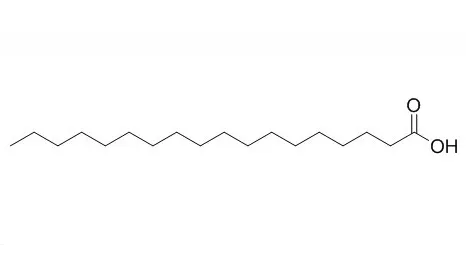METHODS AND RESULTS:
Effects of Stearic Acid supplementation on feed intake and metabolic and production responses of dairy cows with a wide range of milk production (32.2 to 64.4 kg/d) were evaluated in a crossover design experiment with a covariate period. Thirty-two multiparous Holstein cows (142±55 d in milk) were assigned randomly within level of milk yield to treatment sequence. Treatments were diets supplemented (2% of diet dry matter) with Stearic Acid (SA; 98% C18:0) or control (soyhulls). The diets were based on corn silage and alfalfa and contained 24.5% forage neutral detergent fiber, 25.1% starch, and 17.3% crude protein. Treatment periods were 21 d with the final 4 d used for data and sample collection. Compared with the control, SA increased dry matter intake (DMI; 26.1 vs. 25.2 kg/d) and milk yield (40.2 vs. 38.5 kg/d). Stearic Acid had no effect on the concentration of milk components but increased yields of fat (1.42 vs. 1.35 kg/d), protein (1.19 vs. 1.14 kg/d), and lactose (1.96 vs. 1.87 kg/d). The SA treatment increased 3.5% fat-corrected milk (3.5% FCM; 40.5 vs. 38.6 kg/d) but did not affect feed efficiency (3.5% FCM/DMI, 1.55 vs. 1.53), body weight, or body condition score compared with the control. Linear interactions between treatment and level of milk yield during the covariate period were detected for DMI and yields of milk, fat, protein, lactose, and 3.5% FCM; responses to SA were positively related to milk yield of cows. The SA treatment increased crude protein digestibility (67.4 vs. 65.5%), tended to increase neutral detergent fiber digestibility (43.6 vs. 42.3%), decreased fatty acid (FA) digestibility (56.6 vs. 76.1%), and did not affect organic matter digestibility. Fatty acid yield response, calculated as the additional FA yield secreted in milk per unit of additional FA intake, was only 13.3% for total FA and 8.2% for C18:0 plus cis-9 C18:1. Low estimated digestibility of the SA supplement was at least partly responsible for the low FA yield response. Treatment did not affect plasma insulin, glucagon, glucose, and nonesterified FA concentrations.
CONCLUSIONS:
Results show that Stearic Acid has the potential to increase DMI and yields of milk and milk components, without affecting conversion of feed to milk, body condition score, or body weight. Moreover, effects on DMI and yields of milk and milk components were more pronounced for higher-yielding cows than for lower-yielding cows. |






 Cell. 2018 Jan 11;172(1-2):249-261.e12. doi: 10.1016/j.cell.2017.12.019.IF=36.216(2019)
Cell. 2018 Jan 11;172(1-2):249-261.e12. doi: 10.1016/j.cell.2017.12.019.IF=36.216(2019) Cell Metab. 2020 Mar 3;31(3):534-548.e5. doi: 10.1016/j.cmet.2020.01.002.IF=22.415(2019)
Cell Metab. 2020 Mar 3;31(3):534-548.e5. doi: 10.1016/j.cmet.2020.01.002.IF=22.415(2019) Mol Cell. 2017 Nov 16;68(4):673-685.e6. doi: 10.1016/j.molcel.2017.10.022.IF=14.548(2019)
Mol Cell. 2017 Nov 16;68(4):673-685.e6. doi: 10.1016/j.molcel.2017.10.022.IF=14.548(2019)